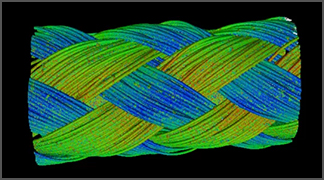3D CT Scan - Services
Part Inspection Lab
We help companies thoroughly investigate
parts & assemblies with our high quality
3D CT scan services paired with
expert analytical support.


PHASE ONE
CONSULTATION
After the initial inquiry, our services begin by having an in-depth discussion with the inquiring individual and interested parties. If the fit is right for our 3D CT scan services, the feasibility review considers part/assembly type, material, regions of interest, and the objective for the CT scan.
PHASE TWO
3D CT – SYSTEM MATCHING
We then match the NDT or Metrology inspection need with one of our many and highly diverse 3D CT imaging machines. Our industrial lab utilizes 100kv, 150kv, 225kv, 450kv, and 3MEV linear accelerator 3D CT systems with LDA’s and flat panel detectors.




PHASE THREE
ANALYSIS
Depending on the 3D CT scan project, we analyze the reconstructed (3D imaging) results for either material or geometry based output requirements.
Material reporting is based upon internal density variations or percent volume changes. These types of 3D CT scan analysis include :
Visualizing virtual cross-sectional slices
Porosity / Inclusion Analysis (Color coded voids, inclusions, and micro pores by volumetric size or percentage)
Enhanced Porosity (Automotive Industry Specific, P201 – 50097, P202 – 50098, P203 Analysis)
Fiber Analysis (Color coded fiber directional reporting)





Geometry reporting is based upon measurement variations or dimensioning requirements. These types of 3D CT scan analysis include :
Part to CAD / Part Comparison (Color coded variations from nominal or another identical part. Alignment by: RPS, 3-2-1 alignment, best fit, sequential)
Wall Thickness Analysis (Color-coded results identifying insufficient or excessive wall thicknes)
First Article Inspection (Tolerancing based upon part print dimensions)
Enhanced FAI (AS9102 Form 3 Reporting)
Reverse Engineering (Generation of a STL file with internal & external part geometry)






PHASE FOUR
REVIEW
As all 3D CT scan projects are unique, each project is finalized between our lab and the customers key decision makers over a results web conference. If required, output deliverables can vary between picture files, excel files, presentations, 3D imaging / CT dataset viewing software, or in some cases STL files.

Need more info on 3D Inspection & Measurement?
Review our knowledge section below.
Overview
Conventional inspection methods such as x-ray testing techniques provide inspection and measurement, which is analyzed in two dimensional form. This limits users in accessing data and analyzing part structures with confidence, as resulting data is restricted to a flat 2D x-ray image. With the introduction and implementation of 3D inspection and measurement testing methods and processes, users are able to access internal and external part data in 3D, providing limitless opportunity for improving quality control. With the use of nondestructive testing labs, industry leaders are able to access 3D inspection test results quickly and accurately.
What is 3D Inspection?
3D inspection is any testing or inspection technique for industrial parts, in which the resulting data is displayed, reviewed and analyzed in 3D form. A 3D virtual image is developed using different inspection techniques for external and/or internal part data. 3D inspection of industrial parts, such as aerospace castings, medical device components, automotive piston heads or machined and engineered parts is significantly useful during pre-production stage of the manufacturing life cycle.
3D inspection allows users to test and investigate part components using different software for failure analysis, dimensional analysis and wall thickness distribution to name a few.
What is 3D Measurement?
3D measurement is the process of accessing external and/or internal dimensions and part geometry in 3D form. A 3D virtual image is developed which is analyzed using specialized software for dimensional analysis. 3D measurement has been a vital tool for accessing measurements of parts for first article inspection reports, geometric dimension and tolerance programming and pre-authorized part approval process.
Types of 3D Inspection
There are many effective technologies accessed by manufacturers today for 3D inspection data and analysis. Some of the most common types of 3D inspection testing techniques include:
3D CT Scan: Radiographic testing technique, utilizing an x-ray source to capture multiple 2D x-ray cross sectional slices. The 2D x-ray slices are reconstructed into a 3D model, for 3D inspection purposes, using a specialized software. This method of 3D inspection can also access 3D measurements and is completely non-destructive.
Laser Scanning: A laser beam is exposed to the surface of the subject and external part data is captured and structured into 3D virtual form, using a software. This method of 3D inspection is for external inspection and measurements.
Structured Light Scanning: With the use of structured light source, such as halogens, the external surface of a part is captured, based on the deformation of the light as it comes into contact with the surface of the part being inspected. The data is reconstructed using a software into 3D form for 3D inspection and measurement purposes.
Applications of 3D Inspection & Measurement
There are several applications for 3D inspection and measurements in regards to industrial testing purposes. Some of the most common types of applications include:
- Failure investigation
- Qualification of parts
- Part approval process
- Wall thickness analysis
- Comparison analysis for internal and external structures in 3D
- Dimensional analysis (FAI reports, PPAP, AS9102, GD&T programming)
Benefits of 3D Inspection & Measurement
3D inspection and measurement allow users to access part data in 3D virtual form. This aids in visualizing and reviewing part structures with high accuracy. Using technologies such as industrial computed tomography or laser scanning, users are able to utilize nondestructive processes and save time and costs of manufacturing part for testing procedures. Moreover, users are able to gain insight on part failures and inconsistencies with accurate measures. As oppose to conventional inspection methods, 3D inspection and measurement assist users in design and prototyping, reviewing part structure and durability. 3D inspection and measurement are also a significant tool for research and development purposes.

